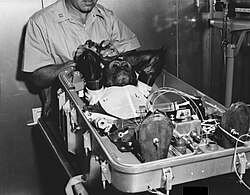Mercury Atlas 5
| Mission dates | |||||||
|---|---|---|---|---|---|---|---|
| Mission: | Mercury Atlas 5 (MA-5) | ||||||
| COSPAR-ID : | 1961-033A | ||||||
| Spacecraft: | Serial number 9 | ||||||
| Launcher: | Atlas D , 93-D | ||||||
| Crew: | Enos, a chimpanzee | ||||||
| Begin: | November 29, 1961, 3:08:00 p.m. UTC | ||||||
| Starting place: | LC-14 , Cape Canaveral | ||||||
| Landing: | November 29, 1961, 18:28:59 UTC | ||||||
| Landing place: | Atlantic | ||||||
| Flight duration: | 3h 20min 59s | ||||||
| Earth orbits: | 2 | ||||||
| Recovery ship: | USS Stormes | ||||||
| Orbit inclination : | 34 ° | ||||||
| Apogee : | 237.2 km | ||||||
| Perigee : | 160.1 km | ||||||
| Covered track: | 81,902 km | ||||||
| Maximum speed: | 28,212 km / h | ||||||
| Maximum acceleration: | 7.7 g | ||||||
| Team photo | |||||||
 Chimpanzee Enos |
|||||||
| ◄ Before / After ► | |||||||
|
|||||||
Mercury-Atlas 5 (MA-5) was on a mission as part of the American Mercury program with the chimpanzee Enos on board.
mission
The capsule arrived at Cape Canaveral Air Force Station on February 24, 1961, and 40 weeks of flight preparation followed, the longest in the entire Mercury program. The capsule was designed first for a suborbital test flight, then for a suborbital test flight with a chimpanzee on board, then for an unmanned three-orbit flight and finally for the mission with which Enos flew. MA-5 was supposed to simulate the flight of MA-6.
Enos' name comes from Hebrew and roughly means human (אֱנוֹשׁ [flowery]: man, person, mortal; cf. also בֶּן אֱנוֹשׁ [literally: son of אֱנוֹשׁ]: man, human; the usual word for "human" would be) . The chimpanzee Enos is from Cameroon (originally Chimp # 81 ) and was acquired by the US Air Force on April 3, 1960 . At the time of the start he weighed 17 kg and was five years old. Eno's surrogate chimpanzees were Duane , Jim , Rocky, and Ham (flew with Mercury-Redstone 2 ).
Five hours before takeoff, Enos was placed in the capsule in his spacesuit. The launch took place at 15:08 UTC on November 29, 1961. Enos was trained to pull levers in response to certain stimuli, whereupon he was rewarded with water and pieces of banana or, in the event of an error, punished with electric shocks. Towards the end of the flight, however, the mechanism failed, so that Enos received electric shocks despite correct reactions. Nevertheless, Enos continued to carry out the tasks.
At the end of the first orbit, the ground crew noticed that the clock in the capsule was up by 18 seconds. During the overflight over Cape Canaveral the clock was synchronized again. Shortly afterwards, the transmission ship in the Atlantic received the first signs of rising temperature in the capsule. These were confirmed by the transmission station in the Canaries. The temperature rose from 18 ° C to 26 ° C. This also caused Eno's body temperature to rise from 37.3 ° C to 38.1 ° C. However, the body temperature did not rise any further, from which the medical observers concluded that the cooling system was working again.
Furthermore, a roll engine failed because of a metal band in a fuel line. As a result, the capsule slowly drifted out of its intended orbit before a corrective boost brought it back again. This was repeated nine times before the re-entry engines ignited and then again before re-entry itself. This consumed more fuel than planned. Towards the end of the second orbit, the medics wanted to send Enos to a third orbit, but the engineers were concerned that the fuel would not be enough. Flight Director Chris Kraft ultimately decided to re-enter after the second round.
The US Navy destroyers USS Stormes and USS Compton and a Martin P5M were waiting in the salvage area . The capsule was sighted by the aircraft three minutes before the splash at an altitude of 1,500 meters. This remained until the arrival of the USS Stormes, an hour and 15 minutes later, and documented the splashdown southeast of Bermuda . The capsule was brought on board the destroyer and the hatch was blown off in a controlled manner. Enos was in good health.
With this successful flight, the Mercury capsule was qualified for manned orbital flights.
Whereabouts
Enos died on November 4, 1962 of diarrhea caused by bacterial agitation. Enos was under constant medical supervision until two months before his death. According to pathologists at Holloman Air Force Base , where he died, there was no connection to his space flight . Mercury Capsule # 9 can be viewed at the North Carolina Museum of Life and Science in Durham , North Carolina .
Web links
- Mercury Atlas 5 (English)
- NASA: MA-5 (22) (English)
- NASA History Series: Chimpanzee into Orbit in This New Ocean: A History of Project Mercury (English)
Individual evidence
- ↑ Loyd S. Swenson Jr., James M. Grimwood, Charles C. Alexander: Chimpanzee into Orbit. In: This New Ocean: A History of Project Mercury. NASA, 1989, p. 404 , accessed February 1, 2017 .
